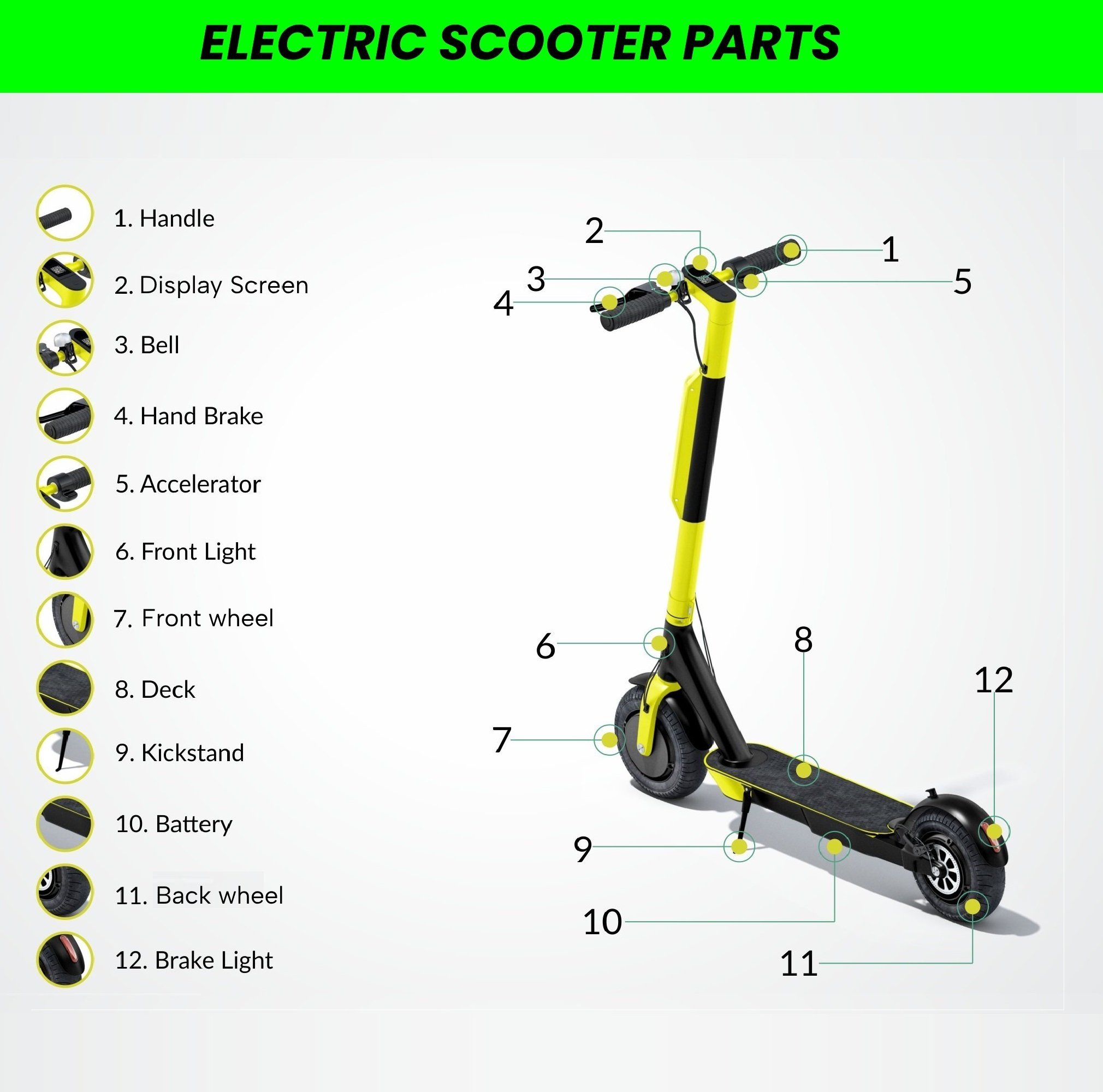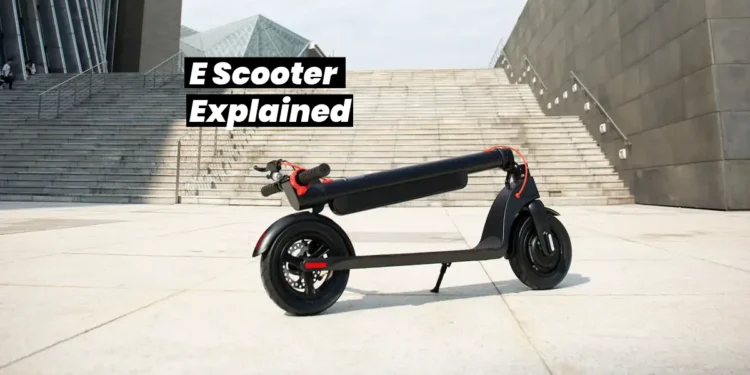Table of Contents
Electric Scooters Basics
1. Overview
The number of electric scooters on the streets is growing daily, and more and more people are realizing that these things aren’t just for fun anymore, in fact they are a viable and efficient means of transportation. And one thing’s for sure is that they are here to stay, actually electric scooters have gained a large market within the past decade, they are much safer than motorbikes and easier to carry and store than e-bikes. Electric scooters have a simple design consisting of three major components : a battery, a controller, and a motor. When the rider twists the throttle located on the handlebar, the battery releases electric energy, which powers the electric motor that moves the wheels. Generally, it’s a straightforward process, but there are some things users should know about each part before purchasing. Modern electric scooters are powered by lithium-ion batteries. These batteries are light, rechargeable, and in some cases, removable.
2. What are the key components of an Electric Scooter?

The key components of an electric scooter are :
- Handlebars : The handlebar is the part that will give you full control over your electric scooter. It is the house for essential controls, such as the throttle, brake lever, and display screen.
- Display screen : Electric scooters generally come with an integrated display screen that shows essential information such as speed, distance traveled, scooter performance, and battery life.
- Bell : A bell on an electric scooter is used to signal your presence and alert walkers, enhancing communication on shared paths and busy areas.
- Hand brake : Electric scooters have one or more braking systems, either electronic, disc, or drum brakes, and a hand brake is the part acting on these systems enhancing safety on the road.
- Accelerator : Or the throttle is the ride’s control, adjusting the electrical power supplied to the electric motor, thus determining the scooter’s speed.
- Front light : Most electric scooter models have built-in LED headlights to stay visible during the night.
- Front wheel : Electric scooters feature diverse wheel types, including air-filled and solid. Typically, the front wheel houses the electric hub motor, although in some cases, it may be present in both the front and rear wheel.
- Deck : The deck is the flat space where the rider stands.. Most micro-mobility brands use rubberized decks for better grip and are wide enough to fit both feet.
- Kickstand : The kickstand on an electric scooter is used to keep the scooter upright and stable when parked.
- Battery : An electric scooter can operate because of the battery. The battery supplies electric power to the motor and other electronic components such as the motherboard. The battery may be lithium-ion, lead-acid, or other types, but lithium-ion is typically the most used type because of their long-lasting power and quick recharge capability.
- Rear wheel : Like the front wheel in an electric scooter the rear wheel is typically equipped with either air-filled or solid tires. Certain brands may include the electric hub motor within the rear wheel for propulsion.
- Brake light : Brake light on an electric scooter signals the rider’s deceleration or stop to other road users.
In addition some electric scooters incorporate front and/or rear suspension systems, engineered to absorb shocks, thereby increasing riding comfort. Also, some models feature a foldable stem (the metal tube connecting the handlebar to the wheel) which can be folded to serve as the main handle for carrying the scooter.
3. How far will an electric scooter go when the battery is fully charged?
How far can an electric scooter go on a full charge is an important question, but actually there is no one answer, it depends on a number of factors including the battery capacity, the motor type, how fast you go and the type of ground you plan to ride over. However, in general, an average electric scooter can take you between 20 to 40 miles. Here are some examples showing the range of some E-scooters :
- Xiaomi M365 (Up to 18.6 miles)
- Segway Ninebot ES2 (Up to 15.5 miles)
- OKAI – Neon II Electric Scooter (Up to 25 miles)
- APOLLO GHOST (Up to 34 miles)
- Dualtron Eagle Pro Electric Scooter (Up to 46.7 miles)
- Segway – G30Max Electric Kick Scooter (Up to 40.4 miles)
4. How to use electric scooters safely?
Understandably, many users are concerned about the safety of riding electric scooters on public roads. Here is a number of things you should keep in mind before and when riding an electric scooter :
- Always check your e-scooter’s tires, it may not be wise to ride an e-scooter if it is underinflated.
- Make sure that the bolts on the stem are tight since the front wheel and the handlebar must stay in alignment.
- Wear a helmet and if you are driving at night you may consider wearing light-colored or fluorescent clothing to make it easier to be seen.
- Don’t hang any heavy thing on the handlebar while driving at high speed, since the handling becomes more sensitive and can put the rider in an unnecessary risk.
- Electric scooters are designed for single riders due to safety concerns, and carrying a passenger can disrupt the scooter’s balance, posing a risk of both riders falling off.
5. Advantages and Disadvantages of an Electric Scooter?
Electric Scooters are now growing in popularity every day. And like any technology there are certain benefits and drawbacks of using an electric scooter and here are some to keep in mind :
Advantages :
- E-scooters are user-friendly with a twist-and-go throttle and they require no driving license or lessons.
- E-scooters are cost-effective for short journeys, with lower operating costs compared to other means of transportation. They represent a cheaper alternative to public transport.
- E-scooters don’t emit harmful gasses during use, promoting environmental sustainability.
- Unlike traditional motorbikes, electric scooters generate less noise, minimizing the negative impact on concentration, stress levels, and overall urban noise pollution.
Disadvantages :
- Electric scooters have limited speed. Yet this disadvantage is not common to all electric scooters.
- E-scooters are capable of exceeding 30mph, which can be dangerous, leading to accidents, particularly among inexperienced users.
- Recharging an e-scooter can be time-consuming, taking 6 to 8 hours or more depending on the battery type.
- E-scooters have a relatively short running range (20 miles to 40 miles), restricting their suitability for long distances. Regardless of the fact that they are engineered for short distances.
















